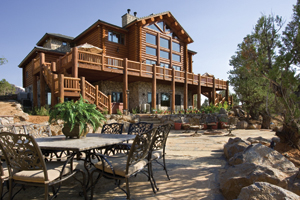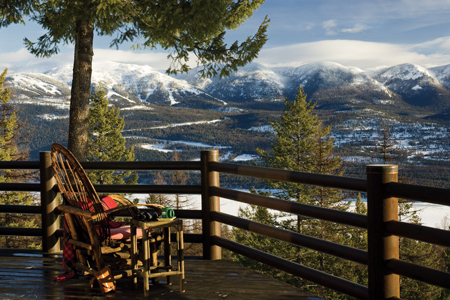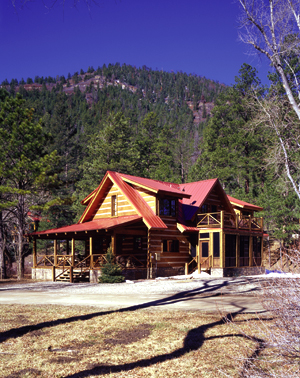When Barry Ivey and Lany Sherman sit down to design a log home these days, some of their customers’ first concerns fall under the “environmentally conscious” category. Looking to incorporate green elements into their homes, both new owners and those looking to retrofit existing structures are concerned about site sustainability, environmentally friendly materials and construction methods, and water and energy efficiency.
“We’re seeing a strong desire for environmentally friendly options in the initial design phase for many of our log homes,” says Ivey, vice president of log home operations at Oakfield, Maine-based Katahdin Cedar Log Homes. “It’s definitely top of mind right now.”
Defining Green
According to the National Association of Home Builders, green homes incorporate environmental considerations and resource efficiency into every step of the building and development process to minimize environmental impact. The design, construction, and operation of the home must focus on energy and water efficiency, resource-efficient building design and materials, and indoor environmental quality and must take the home’s overall impact on the environment into account, says the NAHB.
The number of homes that fall into the green category is growing, as evidenced by the rapid expansion of the government’s Energy Star program, a designation that means a home is at least 20 percent more energy efficient than other new homes. Over 1 million homes nationwide qualify for the designation, which applied to nearly 17 percent of all single-family dwellings built in 2008 (up from 12 percent in 2007).
Log home owners, whose dwellings tend to be “green” by their very nature, are particularly interested in designing and retrofitting their homes in an environmentally friendly manner. “Log homes were green long before green was ‘cool,’” says Jeremy Bertrand, national sales manager for Banner Elk, North Carolina-based Log Homes of America and former executive director of NAHB’s Log Homes Council.
Compare the walls of a log home to those found in a traditionally built structure, for example. The former uses a single, natural building material: wood. The latter, says Bertrand, is made from plywood, drywall, vinyl siding, 2 by 4s, cellulose insulation, paint, and “who knows” what else. “Just looking at the materials alone, you can see that a log home has significantly less impact on the environment,” says Bertrand. “Builders are utilizing what is already there.”
Striving for Efficiencies
When incorporating green design elements into their log homes, Ivey and Sherman first consider energy efficiency for the long term. One way to achieve such efficiency is through a rigid insulation package that keeps homes cool in the summer and warm in the winter. Furring strips are applied to the inside of the log wall, whose interior is covered in log siding or cedar paneling to “maintain the look,” says Sherman, technical support manager.
“This system greatly enhances the R value (a measure of thermal resistance used in the building and construction industries) of the wall,” says Sherman, “and is a big improvement over just a bare wall.”
Site selection is another important aspect of green log homes. Simple decisions like how to position your home so that you don’t have to travel great distances to get to work, shopping, and recreation can go a long way in helping to reduce environmental impact. Orienting the home in the proper direction (taking into account wind barriers and sunlight, for example) is critical, says Sherman. “If you’re using a lot of glass, be sure to face it south to gain solar advantage.”
Log home owners should also maximize floor space, and only make rooms “as large as they have to be,” in spite of the trend to make homes as expansive as possible. Consider room location, says Sherman, who advises owners to keep bedrooms on the leeward side of the home to avoid prevailing winds (which are fine for areas such as closets and storage spaces).
Bertrand suggests porches with large roof overhangs as yet another way to achieve energy efficiency, and points to low-flow toilets, on-demand/instant heating products, natural lighting (via skylights, for example) and “solar tubes” (which use tubes to deliver daylight into the home) as other viable ways to go green.
The Retrofit Approach
Environmentally friendly products can also be incorporated into existing log homes, where Bertrand says some of the most common “green” moves include replacing older commodes with low-flow toilets, updating mechanical systems with energy-efficient HVAC systems and water heaters; purchasing Energy Star appliances; using compact fluorescent lighting; and simply “keeping up with maintenance requirements, such as caulking and sealing the areas between the logs and corners and staining the home on a regular basis.”
If the thought of incorporating green elements into your new or existing log home sends you running to your calculator, take heart. According to John D. Wagner, co-founder of the Certified Green Dealer Program in Lakeview, Minnesota, being friendly to the environment doesn’t have to cost an arm and a leg. Due to their popularity, the products have come down in price and are often incorporated into homes without much additional effort or construction costs.
“Green products are available today at commodity prices,” says Wagner, who points to carpeting, paint, caulk, adhesives, sealants, and finishes as just a few of the materials that come in environmentally friendly varieties. “Manufacturers have scaled up in these areas, and are pumping them out at affordable prices.”

Precision Craft Log & Timber Homes
Not a Radical Departure
The fact that green building is “not exactly a radical departure from traditional building,” says Wagner, also makes it easier for log home designers and owners to create eco-conscious structures. “It’s basically about building the same house, but in a lower-toxic manner that has less impact on the environment around it,” says Wagner.
Expect to see more log home owners taking that stance in the future, says Ivey, who sees issues like energy efficiency (driven by national issues like high fuel prices), water conservation, and carbon footprint reduction (the total set of greenhouse gases caused by a particular person or thing) continuing to play an important role in home design and construction.
“We’re seeing a big desire from the buying public to think ahead and make sure they’re not putting a burden on the environment,” says Ivey. “We don’t see any end in sight to this trend.


